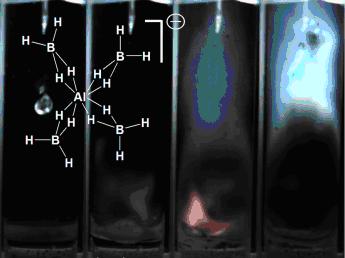A new research approach attempted by Stefan Schneider and his colleagues at the Air Force Laboratory USA (Edwards Air Force Base), and published in the journal Angewandte Chemie, introduces a range of exclusive hydrogen-rich ionic liquids that can self combust when associated with hydrogen peroxide. This research when completed will provide an all new approach to the launch of spacecrafts, rockets and satellites.
Most of the current day spacecrafts, rockets and satellites are propelled by hydrazine and oxidizing agents such as dinitrogen tetroxide or nitric acid. These extremely toxic materials necessitated wearing of protective gears and always posed troubles to the technicians when filling the fuel tanks of the space vehicles. There is also a lurking setback of launch failures and the toxic substances creating ecological problems.
 The ILs presented here are hypergolic with H2O2 and are hydrogen-rich, thus helping to boost performance
The ILs presented here are hypergolic with H2O2 and are hydrogen-rich, thus helping to boost performance
In spite of its known hazardous characteristics hydrazine is preferred to fuel the rockets due to its high level combustion performance, long duration storage features and instant igniting qualities when associated with a catalyst or oxidizing agent. Also the oxidizing agents are considered to be equally unsafe. While nitric acid is more corrosive, dinitrogen tetroxide is highly volatile and toxic. Hydrogen peroxide is considered as an ideal substitute because of its less corrosive attributes, generates reduced level of toxic gas at room temperature and when decomposed it produced only oxygen and water.
The researchers have attempted to use ionic liquids that comprise both positive and negatively charged ions like that of a salt. The non-crystalline ionic liquids used remained molten at room temperature and did not vaporize, thus preventing the production of toxic vapors.
The team also has overcome the problem of the passive non-combustive reaction of ionic liquids when used along with hydrogen peroxide. The ionic liquid used by them has a phosphorus atom bonded to four hydrocarbon chains as the positively charged ion. At the center it was having a negatively charged ion comprising one aluminum, sixteen hydrogen and four boron atoms.
The mix with its high level of hydrogen content increased the combustion power of the fuel. According to Schneider, for a specific tank size, it was observed that liquids containing this ion have more hydrogen than liquids of pure hydrogen without using any complicated cooling requirements. The new ionic liquid reacted positively and instantly when contacted with hydrogen peroxide, thus finding a latent greener element for a fuel in space vehicles.